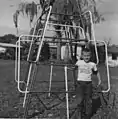Jungle gym
The jungle gym, also called monkey bars or climbing frame, is a piece of playground equipment made of many pieces of material, such as metal pipe or rope, on which participants can climb, hang, sit, and in some configurations slide.

History

The first jungle gym was invented in 1920 and patented by lawyer Sebastian Hinton, in Chicago.[1] It was sold under the trademarked name Junglegym. The term "monkey bars" appears at least as far back as the 1930s,[2][3] though Hinton's initial patent of 1920 appeals to the "monkey instinct" in claiming the benefits of climbing as exercise and play for children,[4] and his improvement patents later that year refer to monkeys shaking the bars of a cage, children swinging on a "monkey runway", and the game of "monkey tag".[5] Hinton's father, mathematician Charles Hinton, had built a similar structure from bamboo when Sebastian Hinton was a child; his father's goal was to enable children to achieve an intuitive understanding of three-dimensional space through a game in which numbers for the x, y, and z axes were called out, and each child tried to be the first to grasp the indicated junction. Thus, the abstraction of Cartesian coordinates could be grasped as a name of a tangible point in space.[6]
Hinton's second prototype jungle gym is still standing at Crow Island School.[6][7]
 A small jungle gym
A small jungle gym Hanging from monkey bars
Hanging from monkey bars Landscape structures mobius climber
Landscape structures mobius climber Landscape structures spacenet climber
Landscape structures spacenet climber Boy in front of jungle gym, 1967
Boy in front of jungle gym, 1967 A jungle gym in a school yard at Gärdet in Stockholm, Sweden, 2012
A jungle gym in a school yard at Gärdet in Stockholm, Sweden, 2012
 A jungle gym in Råcksta, Stockholm, Sweden, 2016
A jungle gym in Råcksta, Stockholm, Sweden, 2016 Military variant
Military variant
Safety
To reduce the risk of injury from falls, jungle gym areas often have a thick layer of woodchips or other impact-absorbing material covering the ground. The US National Safety Council recommends that playgrounds have at least 12 inches (30 cm) of such material.[8]
References
- Hinton's original patents for the "climbing structure" are U.S. Patent 1,471,465 filed July 22, 1920; U.S. Patent 1,488,244 filed October 1, 1920; U.S. Patent 1,488,245 filed October 1, 1920; and U.S. Patent 1,488,246 filed October 24, 1921.
- DISTRICT OF COLUMBIA APPROPRIATION BILL FOR 1939 HEARINGS BEFORE THE SUBCOMMITTEE OF THE COMMITTEE ON APPROPRIATIONS UNITED STATES SENATE. 1938-01-01.
- Negligence and Compensation Cases Annotated. Callaghan. 1937-01-01.
- In U.S. Patent 1,471,465 Hinton wrote on page 3, "Again and importantly, the monkey instinct strong in all human beings and perhaps more clearly displayed in children, makes climbing a sport to which children enthusiastically take, by a psychology about the same as that of a kitten at play with a ball, which of course is practice for hunting."
- In U.S. Patent 1,488,244 Hinton wrote on page 3, "I have found, however, that children seem to like to climb through the structure to some particular point, and there swing head downward by the knees, calling back and forth to each other, a trick which can be explained of course only by the monkey instinct", and on page 4 he wrote, "I make considerable point of the great strength of the structure, as this is important. Thus most persons have seen a monkey in a zoo, seize the bars of his cage with hands and feet and throw his body violently back and forth, other monkeys following suit. Children in the structure I have erected do the same thing, apparently unconscious of any imitation of monkeys. It can be appreciated that with twenty-five or thirty heavy boys doing this, the strains on the structure are very great."
- "'J' is for Jungle Gym" from Winnetka, Illinois Historical Society
- "About Us / History". Crow Island School history. Retrieved 2020-02-27.
- Playground Safety – National Safety Council Archived 2006-12-10 at the Wayback Machine
External links
 Media related to Jungle gyms at Wikimedia Commons
Media related to Jungle gyms at Wikimedia Commons
